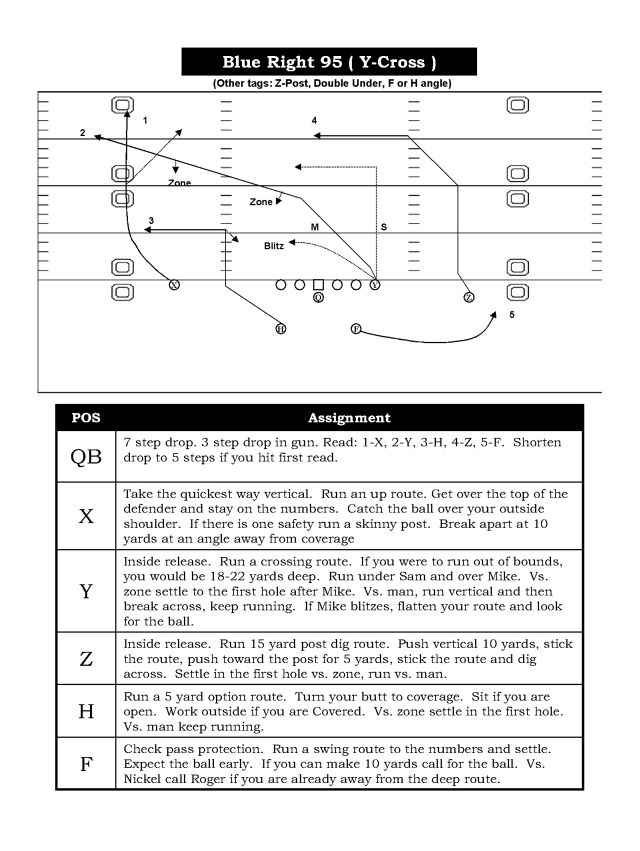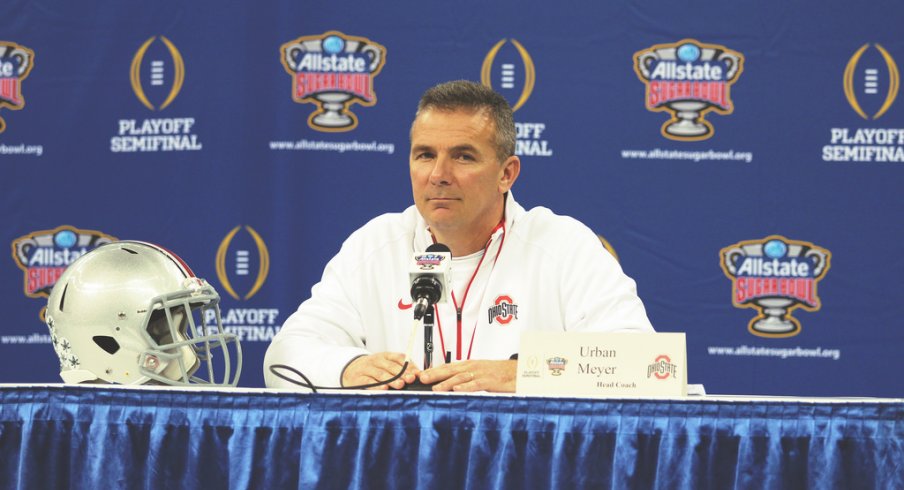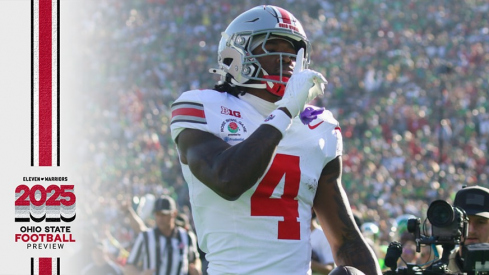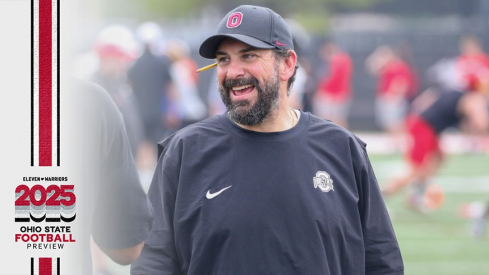Though I've been writing these Film Studies for three years, nearly every single piece has been written because I thought it was important. While some of you have asked a number of questions in the comments over this time, I've never actually tried to find out what topics you find most interesting.
So, I figured for one week I'd see what the 11W and Twitter commentariats actually might find useful, and I opened myself up to receive the following questions. After receiving dozens of responses, I tried to narrow them down by selecting a variety of topics while avoiding repetition.
Nick Kelly asked: "Is IZR still what the offense is built around? Generally is zone blocking still more prevalent than man?"
By all accounts, yes, the Inside Zone-Read (referred to as 'Tight' zone in Meyer's playbook) is still the bedrock concept of the Ohio State offense. If anything, Kevin Wilson was hired because of his knowledge of the concept, having been one of the seminal figures in its development during his time as Northwestern's offensive coordinator in the late 90s.
That said, while the Buckeyes' play-calling has often been criticized for a lack of creativity through the air, they've long had one of the more diverse and balanced run games in the nation. The Tight Zone works best when complemented by gap-blocked schemes like Power-O, Counter, and the Buck Sweep, each of which requires the line to master different footwork and technical rules. Not only is the combination effective, it's turned Buckeye linemen into desirable pros, given that they've already mastered most of the concepts found in every NFL playbook before they ever leave Columbus.
But though the inside zone continues to be installed on the first day of camp, the manner in which it's run has changed over time. Though Meyer initially built his offense around one-back principles, making the quarterback the second potential ball-carrier by way of the option game, the use of tight ends in the backfield in 'Y-off' alignments has turned many run plays back into the old I-formation schemes with a lead blocker for the back.
Wilson, who cut his teeth as an offensive line coach in two-back systems during the 80s and 90s, offers a wealth of experience here that may prove invaluable. Though the QB may still be reading an unblocked man at the end of the line, the inside zone of 2017 may end up looking more like the version we saw in 1997 than 2007.
GrandTheftHarley asked: "Would it be possible for you to compare/contrast the RPO approaches of both Tom Herman and Kevin Wilson?"
It's hard for me to say exactly how Herman views run-pass options (RPOs) today, given the rapid advancements in this area of the game over the past two years, but I do know Wilson and new QB coach Ryan Day seem to have a different definition of what constitutes an RPO. The term is obviously a loose one, as the combination of any running play with a potential pass route is technically an RPO, but OSU's new offensive brain trust approaches the matter a bit differently.
Most RPOs seen today simply add a screen pass at or behind the line of scrimmage, quickly distributing the ball to open space and punishing the defense for over-playing the run. For the quarterback, these decisions are very straightforward: "If not A, then B."
Teams can include as many as four decisions like these on the play, as teams like Ole Miss, Auburn, and Washington have become known for:
But the QB's decision tree remains linear, in these instances, which Wilson and Day refer to as 'reliefs.'
Now, in Columbus, an RPO means the combination of a run play with a multiple-route concept on the outsides, meaning the quarterback has to read the coverage after deciding whether to hand off, and giving him the thought process of "If not A, then 1, 2, or 3."
While a relief route can be added to any run concept at almost any time, these more complex RPOs are called far more infrequently. Not only does the quarterback have even more responsibility than normal, he's put at risk with all the linemen in front of him trying to open holes for a runner instead of sitting back in pass protection.
This is the most common criticism of RPOs, as any kind of blitz can disrupt the play entirely and turn the QB into a sitting duck. If anything, running these kinds of RPOs incentivizes the defense to be more aggressive in response.
It's hard to say for sure how often we'll see the Buckeyes running these dual concepts this fall, though. Given the existing struggles in the passing game, adding another wrinkle to the mix before fixing the fundamental flaws may be asking a bit too much.
Brian Cockerham asked: "Are all 3 LB spots interchangeable now? Just following what some players say and that's how it seems."
Though it may seem that way, given the way Chris Worley, Jerome Baker, and Dante Booker have moved around between the Sam, Mike, and Will positions throughout their careers, the answer is still a no. While Darron Lee, Josh Perry, and Curtis Grant were all different kinds of players when Chris Ash arrived in 2014, the three current starters at linebacker all most resemble Lee while still holding very different responsibilities at each spot.
Lee's former Sam role is primarily an edge player against the run, turning the ball-carrier back inside and hopefully into the waiting arms of the Mike, who should be the best tackler on the roster. The staff obviously feels that Worley holds that title, making him the best candidate to play inside at Mike.
However, Lee's brilliance at Sam became a clear coaching point in opposing game plans during the 2015 season, as offenses began scheming away from his side of the field. Once it became clear how Lee and the Buckeyes would align to the strength of the opposing formation, teams would simply run or throw away from him, forcing Perry into the outside role Lee was best fit to play.
While before, the Mike and Will spots were most similar, as they both often lined up between the tackles, today the Sam and Will are most alike, as either player can find themselves outside over a slot receiver or over the B-gap on any given play.
Hovenaut asked: "Do you find yourself always looking to break down/capture the intricacies of each play, or are you able to filter and simply enjoy the game from a fan perspective?"
I've touched on this before, but I often focus on the offensive line while watching games live, especially in the first quarter. Given the tv camera angles, it's tough to get a real feel for anything happening outside of that area while watching live, but it's also the best way to understand how either team will attack on the ground.
Once both teams have run 20 plays or so, it becomes pretty clear what they're trying to do with their running games, and my focus is no longer on identification, allowing me to sit back and enjoy just watching the game a little bit more.
However, while an Ohio State game is going on, I'm usually plugged into a group message thread with my esteemed colleagues, giving them my thoughts and observations on the proceedings. Given that I'm not facing a deadline to publish mere minutes after the game like they are, though, I get to take part in the post-game festivities associated with fandom, meaning that I get to experience the best of both worlds.
1MechEng asked: "A couple of years back, there was talk of the mythical diamond formation. Can you detail why or why not it makes sense for this team?"
The diamond formation hasn't been seen very often in the college football world, if for no other reason than it shrinks the field in an era when there is a premium placed on horizontally stretching it. Oklahoma State and West Virginia have been known to show it from time to time, but they're also running variations of the Air Raid, meaning the novelty of putting four players in the backfield at once simply catches opponents off guard more than anything.
Given that the Buckeyes are adept at running the ball in countless ways, as described earlier, there's need to take away one weapon (spreading the field) to find another (running the ball). They get to do both at once.
KBonay asked: "TE Screen against Nebraska. Jake Stoneburner for 32-yard TD. Never seen it again. Why?
There's no question these kinds of constraint plays are fun to watch, but they only work when no one expects them. That said, as a former tight end myself I 100% support more TE screen passes.
Cdub4 asked: "What players from other teams really impress you from watching film, particularly in the passing game. What are their strengths? What makes the Deshaun Watson's and Christian Kirk's special? Quickness through progressions, route running, etc."
At the college level, 'Jimmys and Joes' still beat Xs and Os most of the time. Players like Watson, Kirk, or Lamar Jackson still blow me away in the eye test the same way they do to anyone else.
What I love to see at the college level is the ability to be elite at one or two skills that can be seen on any play, whether it's using your hands to separate on the line like Michael Thomas could, or the way Jourdan Lewis could still run step-for-step with him throughout the route. What I don't get into are players that have a spectacular skill or talent that can only be leveraged in special circumstances, like lightning-fast punt returner or giant receiver whose only skill is winning jump balls in the end zone. Those are certainly nice tools to have but don't impress me if that's the first thing you say about a player.
For that reason, I can say with all honesty that I had no trouble filling the month of December with nothing but Clemson previews because they had so much talent to watch. I actually got excited to keep reviewing more and more film on them.
Yes, they were running some advanced stuff on both sides of the ball, but they were doing so because they had special athletes all over the place that were capable of executing NFL-caliber tactics. It's also for that reason, that I wasn't shocked that the Buckeyes didn't get past them in the Fiesta Bowl (although I obviously didn't think it would be THAT bad).
Buck15 asked: "This may be a bit of hot take, but do you think Urban Meyer is overrated when it comes to X's and O's? We saw the results of the offense that past two seasons with the talent we had, especially in 2015, and frankly the buck stops at him."
While this take may be approaching near molten levels in some circles, I see your point. Meyer was definitely one of the leading figures of the 'Spread' movement that has gotten so big the name doesn't even mean anything these days.
But...since his offense looks so much like everyone else's at this point, it's hard to say that his offenses have been the most innovative, at least at first glance. The national championship season of 2014 was filled with all kinds of subtle tweaks to beat the variety of aggressive defensive fronts they were seeing each week, and although they had the kitchen sink thrown at them, the Buckeyes kept running the ball better and better as the year went on.
However, from what I know about his philosophy, Meyer isn't the type to try and over-complicate things just for the sake of variety. Rather, execution and performance are what he spends the most of his time thinking about.
For instance, though there were some added wrinkles in the infamous 2015 Sugar Bowl victory over Alabama, Meyer and his staff have been open about the difference in the game coming from little things like hand placement technique, not the game plan.
My favorite part about this entire argument is it's about a coach who has never actually held the title of offensive coordinator or even called the plays on every down, but that's just me.
LouBuck35 asked: "What is your favorite play/formation that Meyer has utilized in his time here and why has it worked so well? Is it your favorite because of its creativity, effectiveness or both?"
This is tough because it's hard not to take historical significance into play. The one I'll remember most came in that same in that same Sugar Bowl win over the Crimson Tide, and allowed a pretty good running back to gallop 85 yards through the heart of the south. You may have seen it.

However, when simply looking at things in a vacuum, I love seeing the old Air Raid classic 'Y-Cross' included in Buckeye game plans. Like many of Mike Leach and Hal Mumme's signature concepts, this one can trace its roots back to BYU's LaVell Edwards and Norm Chow, two of the most underappreciated innovators of the modern passing game.
The concept itself is quite simple, giving the QB a read from one side to another and including a deep ball threat on the outside with two crossing routes that can work against either man or zone coverage. However, it's also quite successful against teams bringing pressure despite the relatively long development time, as only three receivers are truly required, allowing backs or a tight end to stay in and block.
However, because the initial concept is so simple, flooding one side of the field, countless tweaks and wrinkles can be inserted to counter defensive adjustments, cutting off routes early or changing the depth of the crosser. Additionally, it can be run from all kinds of formations, though the Buckeyes tend to call it most from bunch sets, allowing the crosser to get off the line without contact.
For all of the warts in Ohio State's passing game last fall, this concept was a consistent bright spot, igniting not only J.T. Barrett, but also receivers not named Curtis Samuel. Given the fact that Wilson took over for Leach as the O.C. at Oklahoma and called the play countless times during his time there, I'd venture to guess we'll see this concept quite a bit this fall.
IBLEEDSCARLETANDGRAY asked: "Did you see anything in the Spring Game film that secretly made you giddy? Like a new wrinkle that Kevin Wilson is about to unleash?"
As a member of the 11W team I am both obligated and delighted to answer with one play:
Just like all my colleagues here on this fine website, I'm also a believer in the G.O.A.T.
Have any other questions that weren't answered? Ask away in the comments and I'll try to get to as many as I can.



